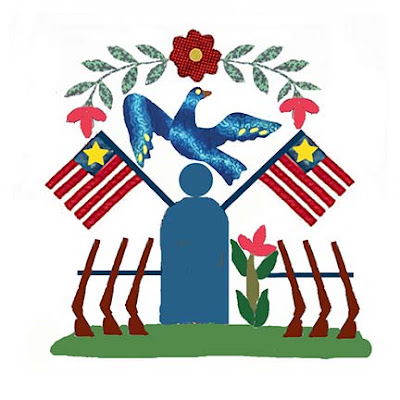The Mexican War of the 1840s rang many chords in Baltimore. The move to increase slave-holding Southern territory by annexing Mexican land west of Louisiana increased the U.S. territory by about 33%.
Quiltmakers showed religious and social affiliations, temperance enthusiasm and pride in the city in the appliqued album quilts they began making in the mid 1840s there.
The quilt artists also captured warhawk sentiment with patriotic images such as eagles and flags. The most obvious allusion to the nearly 2-year war is seen in monuments to fallen heroes Major Samuel Ringgold and Colonel William H. Watson.
I'd always assumed these architectural structures represented the martyred soldiers' tombs where they are buried but Baltimore Album Quilt expert Virginia Vis tells me the repeated image is of a cenotaph, a once-common word for a memorial that does not mark a grave.
"The Mexican War hero monuments were temporary structures in the open space of the Baltimore Merchants Exchange. The rifles were leaned up against the 'fence' around the structures with the names [to keep] the public at a distance...."
I checked the newspapers of 1846 and found much about the temporary cenotaph constructed for Samuel Ringgold that was supposed to be 22 feet tall, constructed of wood by local builders the Gifford Brothers, topped with an eagle and draped for drama by a Baltimore draper named Shole. The rifles pictured in the quilt blocks were actual weapons propped up to define the space and add more martial reminders to the mix.
Ringgold and perhaps Watson lay in state near this structure for a few days in December, 1846 and then went on to less magnificent final resting places.
The BAQ History Crew has identified several quilts with the Ringgold memorial and two or three with the Watson reference. Imagery and fabrics in the blocks seem to fall into two major categories leading us to assume that at least two professional seamstresses offered their interpretations for the patriotic customer to include in her quilt. Were they kits, patterns or finished blocks?
We have no period photo of the monument in 1846. Twenty-two feet is about 2 stories tall, perhaps an exaggeration---although the rotunda with its dome could have accommodated a sculpture that tall. We can compare size in the rifles edging the scene.
The Springfield rifle of the time was 56 inches long. The structure in the Shelburne's Major Ringgold quilt is about twice the size making it a little taller than 9 feet--- impressive but not 2 stories.
https://barbarabrackman.blogspot.com/2024/05/anglo-saxon-quilts-2-mexican-war.html
Quilt in collection of the International Quilt Museum with 3 memorial blocks.


















No comments:
Post a Comment